#Oscars de Bordeaux
Explore tagged Tumblr posts
Text

Annonce de spectacles culturels à Bordeaux (théatre, cinema, musique, …) pour la saison commençant en octobre 1969. / Announcement of cultural shows in Bordeaux (theater, cinema, music, …) for the season starting in October 1969.
Duke Ellington, Miles Davis, Cecil Taylor, Pharoah Sanders, Michel Portal, Oscar Peterson, Ronnie Scott, …
#jazz#poster flyer#duke ellington#miles davis#cecil taylor#pharoah sanders#michel portal#oscar peterson#ronnie scott#1969
32 notes
·
View notes
Text
rip Oscar François de Jarjayes you probably had so many gender breakdowns over Yde from the Huon de Bordeaux sequel poem cycles
11 notes
·
View notes
Photo

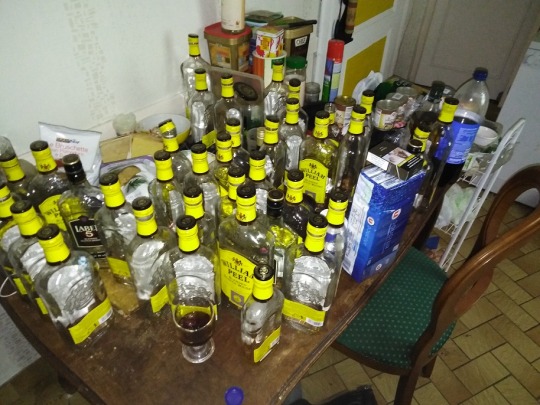

Angers sporting club Saïd Chabane Gérald Baticle, Bordeaux Football Club des Girondins Gérard Lopez Vladimir Petkovic, Brest Stade brestois Denis Le Saint Michel Der Zakarian, Clermont-Ferrand Clermont Foot Ahmet Schaefer Pascal Gastien, Lens Racing Club Joseph Oughourlian Franck Haise, Lille LOSC Olivier Létang Jocelyn Gourvennec, Lorient Loïc Féry Christophe Pélissier, Lyon OL Olympique lyonnais Jean-Michel Aulas Peter Bosz, Olympique de Marseille OM Pablo Longoria Jorge Sampaoli, Metz Football Club Bernard Serin Frédéric Antonetti, Monaco AS Association sportive Monaco FC Dmitri Rybolovlev Niko Kovac, Montpellier-Herault Sport Club Laurent Nicollin Olivier Dall'Oglio, Nantes Football Club Waldemar Kita Antoine Kombouare, Nice OGC Jean-Pierre Rivère Christophe Galtier, Paris PSG Nasser Al-Khelaifi Mauricio Pochettino Kylian Mbappé Lionel Messi Neymar da Silva, Reims Stade de Reims Jean-Pierre Caillot Oscar Garcia, Rennes Stade rennais Football Club Nicolas Holveck Bruno Genesio, Saint-Étienne ASSE Association sportive Roland Romeyer Bernard Caïazzo Claude Puel, Strasbourg Racing Club de Strasbourd Alsace Marc Keller Julien Stephan, Troyes Simon Cliff Laurent Battles Ajaccio AC Athletic Club Ajaccien Christian Lecat Olivier Pantaloni, Amiens Sporting Club Football bernard Joannin Philippe Hinschberger, Auxerre James Zhou Jean-Marc Furlan, Bastia SC Sporting Club Claude Ferrandi Mathieu Chabert, Caen Stade Malherbe Olivier Pickeu Stéphane Moulin, Dunkerque Union Sportive du Littoral Jean-Pierre Scouarnec Romain Revelli, Dijon Football Côte-d'Or Olivier Delcourt David Linares, Grenoble Foot 38 Stéphane Rosnoblet Maurizio Jacobacci, Guingamp En Avant Fred Legrand Stéphane Dumont, Le Havre Athletic Club Football Vincent Volpe Paul Le Guen, Nancy Association Sportive Nancy-Lorraine Jacques Rousselot Daniel Stendel, Nîmes Olympique Rani Assaf Pascal Plancque, Niort Chamois Niortais Football Club Guy Cotret Sébastien Desabre, Paris FC Pierre Ferracci Thierry Laurey, Pau Football Club Bernard Laporte-Fray Didier Tholot, Quevilly-Rouen Union Sportive Michel Mallet Bruno Irles, Rodez Aveyron Football Club Pierre-Olivier Murat Laurent Peyrelade, Sochaux Football Club Frankie Yau Omar Daf, Toulouse Football Club Damien Comolli Philippe Montanier, Valenciennes Football Club Eddy Zdziech Olivier Guegan 24h du Mans Alice Pérésan-Roudil Amazon Avatar Barbie Batman Beyonce Black Mirror Bordeaux Boulevard Voltaire Cannes Champion League Chargé de création graphique Chat GPT Château Circuit Bugatti Coupe du Monde Damien Bridonneau Didier Deschamps Didier Raoult Disney Dua Lipa Elon Musk Emmanuel Macron Eurovision Fasting Féminicide Football Gérald Darmanin Gérard Depardieu Gilbert Bordes Guillaume Musso Incendie Inflation Instagram Jean-Luc Mélenchon Jeux olympiques Johnny Depp Jordan Bardella Justine Triet Keto diet Ligue 1 Liverpool Lizzo Margo Robbie Marine Le Pen Marseille Marvel Mediapart Monster energy Mylène Farmer Netflix Nicolas Sarkozy Novak Djokovic NUPES Olivier Dussopt Olivier Véran Olympic games Olympics Olympique de Marseille OMAD Paris Paris 2024 Paris Saint-Germain PSG Qatar Rodez Roman Polanski Retraites Russia Russie Sandrine Rousseau Sécheresse Star Wars Succession Taylor Swift The Office Tik Tok Ukraine Union Unionizing Virginie Grimaldi Woke Wokiste
1 note
·
View note
Text
Le concert de Hans Zimmer à l'Arkea Arena de Bordeaux a été marqué par un spectacle grandiose et démesuré.
Achat cd : https://amzn.to/42fpFIZ Ce mardi 9 mai à l’Arkea Arena, le compositeur Hans Zimmer, lauréat de deux Oscars, dirige en personne un orchestre symphonique augmenté de musiciens rock pour interpréter ses plus grandes musiques de films. En tournée mondiale, Zimmer, autodidacte de 66 ans, il est accompagné par des chanteurs et musiciens ukrainiens de l’Opéra d’Odessa, ainsi que d’artistes…

View On WordPress
0 notes
Text
Two Hundred Fifty Things an Architect Should Know
by Michael Sorkin
1. The feel of cool marble under bare feet. 2. How to live in a small room with five strangers for six months. 3. With the same strangers in a lifeboat for one week. 4. The modulus of rupture. 5. The distance a shout carries in the city. 6. The distance of a whisper. 7. Everything possible about Hatshepsut’s temple (try not to see it as ‘modernist’ avant la lettre).

The Temple of Hatshepsut
8. The number of people with rent subsidies in New York City. 9. In your town (include the rich). 10. The flowering season for azaleas. 11. The insulating properties of glass. 12. The history of its production and use. 13. And of its meaning. 14. How to lay bricks. 15. What Victor Hugo really meant by ‘this will kill that.’ 16. The rate at which the seas are rising. 17. Building information modeling (BIM). 18. How to unclog a Rapidograph. 19. The Gini coefficient. 20. A comfortable tread-to-riser ratio for a six-year-old. 21. In a wheelchair. 22. The energy embodied in aluminum. 23. How to turn a corner. 24. How to design a corner. 25. How to sit in a corner. 26. How Antoni Gaudí modeled the Sagrada Família and calculated its structure. 27. The proportioning system for the Villa Rotonda. 28. The rate at which that carpet you specified off-gasses. 29. The relevant sections of the Code of Hammurabi. 30. The migratory patterns of warblers and other seasonal travellers. 31. The basics of mud construction. 32. The direction of prevailing winds. 33. Hydrology is destiny. 34. Jane Jacobs in and out. 35. Something about feng shui. 36. Something about Vastu Shilpa. 37. Elementary ergonomics. 38. The color wheel. 39. What the client wants. 40. What the client thinks it wants. 41. What the client needs. 42. What the client can afford. 43. What the planet can afford. 44. The theoretical bases for modernity and a great deal about its factions and inflections. 45. What post-Fordism means for the mode of production of building. 46. Another language. 47. What the brick really wants. 48. The difference between Winchester Cathedral and a bicycle shed. 49. What went wrong in Fatehpur Sikri. 50. What went wrong in Pruitt-Igoe. 51. What went wrong with the Tacoma Narrows Bridge. 52. Where the CCTV cameras are. 53. Why Mies really left Germany. 54. How people lived in Çatal Hüyük. 55. The structural properties of tufa. 56. How to calculate the dimensions of brise-soleil. 57. The kilowatt costs of photovoltaic cells. 58. Vitruvius. 59. Walter Benjamin. 60. Marshall Berman. 61. The secrets of the success of Robert Moses. 62. How the dome on the Duomo in Florence was built.

Duomo in Florence
63. The reciprocal influences of Chinese and Japanese building. 64. The cycle of the Ise Shrine. 65. Entasis. 66. The history of Soweto. 67. What it’s like to walk down the Ramblas. 68. Back-up. 69. The proper proportions of a gin martini. 70. Shear and moment. 71. Shakespeare, et cetera. 72. How the crow flies. 73. The difference between a ghetto and a neighborhood. 74. How the pyramids were built. 75. Why. 76. The pleasures of the suburbs. 77. The horrors. 78. The quality of light passing through ice. 79. The meaninglessness of borders. 80. The reasons for their tenacity. 81. The creativity of the ecotone. 82. The need for freaks. 83. Accidents must happen. 84. It is possible to begin designing anywhere. 85. The smell of concrete after rain. 86. The angle of the sun at the equinox. 87. How to ride a bicycle. 88. The depth of the aquifer beneath you. 89. The slope of a handicapped ramp. 90. The wages of construction workers. 91. Perspective by hand. 92. Sentence structure. 93. The pleasure of a spritz at sunset at a table by the Grand Canal. 94. The thrill of the ride. 95. Where materials come from. 96. How to get lost. 97. The pattern of artificial light at night, seen from space. 98. What human differences are defensible in practice. 99. Creation is a patient search. 100. The debate between Otto Wagner and Camillo Sitte. 101. The reasons for the split between architecture and engineering. 102. Many ideas about what constitutes utopia. 103. The social and formal organization of the villages of the Dogon. 104. Brutalism, Bowellism, and the Baroque. 105. How to dérive. 106. Woodshop safety. 107. A great deal about the Gothic. 108. The architectural impact of colonialism on the cities of North Africa. 109. A distaste for imperialism. 110. The history of Beijing.

Beijing Skyline
111. Dutch domestic architecture in the 17th century. 112. Aristotle’s Politics. 113. His Poetics. 114. The basics of wattle and daub. 115. The origins of the balloon frame. 116. The rate at which copper acquires its patina. 117. The levels of particulates in the air of Tianjin. 118. The capacity of white pine trees to sequester carbon. 119. Where else to sink it. 120. The fire code. 121. The seismic code. 122. The health code. 123. The Romantics, throughout the arts and philosophy. 124. How to listen closely. 125. That there is a big danger in working in a single medium. The logjam you don’t even know you’re stuck in will be broken by a shift in representation. 126. The exquisite corpse. 127. Scissors, stone, paper. 128. Good Bordeaux. 129. Good beer. 130. How to escape a maze. 131. QWERTY. 132. Fear. 133. Finding your way around Prague, Fez, Shanghai, Johannesburg, Kyoto, Rio, Mexico, Solo, Benares, Bangkok, Leningrad, Isfahan. 134. The proper way to behave with interns. 135. Maya, Revit, Catia, whatever. 136. The history of big machines, including those that can fly. 137. How to calculate ecological footprints. 138. Three good lunch spots within walking distance. 139. The value of human life. 140. Who pays. 141. Who profits. 142. The Venturi effect. 143. How people pee. 144. What to refuse to do, even for the money. 145. The fine print in the contract. 146. A smattering of naval architecture. 147. The idea of too far. 148. The idea of too close. 149. Burial practices in a wide range of cultures. 150. The density needed to support a pharmacy. 151. The density needed to support a subway. 152. The effect of the design of your city on food miles for fresh produce. 153. Lewis Mumford and Patrick Geddes. 154. Capability Brown, André Le Nôtre, Frederick Law Olmsted, Muso Soseki, Ji Cheng, and Roberto Burle Marx. 155. Constructivism, in and out. 156. Sinan. 157. Squatter settlements via visits and conversations with residents. 158. The history and techniques of architectural representation across cultures. 159. Several other artistic media. 160. A bit of chemistry and physics. 161. Geodesics. 162. Geodetics. 163. Geomorphology. 164. Geography. 165. The Law of the Andes. 166. Cappadocia first-hand.
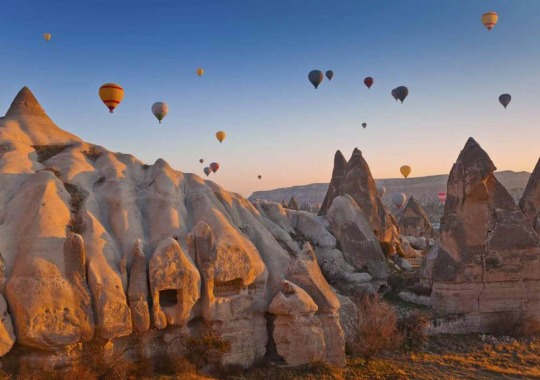
Cappadocia
167. The importance of the Amazon. 168. How to patch leaks. 169. What makes you happy. 170. The components of a comfortable environment for sleep. 171. The view from the Acropolis. 172. The way to Santa Fe. 173. The Seven Wonders of the Ancient World. 174. Where to eat in Brooklyn. 175. Half as much as a London cabbie. 176. The Nolli Plan. 177. The Cerdà Plan. 178. The Haussmann Plan. 179. Slope analysis. 180. Darkroom procedures and Photoshop. 181. Dawn breaking after a bender. 182. Styles of genealogy and taxonomy. 183. Betty Friedan. 184. Guy Debord. 185. Ant Farm. 186. Archigram. 187. Club Med. 188. Crepuscule in Dharamshala. 189. Solid geometry. 190. Strengths of materials (if only intuitively). 191. Ha Long Bay. 192. What’s been accomplished in Medellín. 193. In Rio. 194. In Calcutta. 195. In Curitiba. 196. In Mumbai. 197. Who practices? (It is your duty to secure this space for all who want to.) 198. Why you think architecture does any good. 199. The depreciation cycle. 200. What rusts. 201. Good model-making techniques in wood and cardboard. 202. How to play a musical instrument. 203. Which way the wind blows. 204. The acoustical properties of trees and shrubs. 205. How to guard a house from floods. 206. The connection between the Suprematists and Zaha. 207. The connection between Oscar Niemeyer and Zaha. 208. Where north (or south) is. 209. How to give directions, efficiently and courteously. 210. Stadtluft macht frei. 211. Underneath the pavement the beach. 212. Underneath the beach the pavement. 213. The germ theory of disease. 214. The importance of vitamin D. 215. How close is too close. 216. The capacity of a bioswale to recharge the aquifer. 217. The draught of ferries. 218. Bicycle safety and etiquette. 219. The difference between gabions and riprap. 220. The acoustic performance of Boston Symphony Hall.

Boston Symphony Hall
221. How to open the window. 222. The diameter of the earth. 223. The number of gallons of water used in a shower. 224. The distance at which you can recognize faces. 225. How and when to bribe public officials (for the greater good). 226. Concrete finishes. 227. Brick bonds. 228. The Housing Question by Friedrich Engels. 229. The prismatic charms of Greek island towns. 230. The energy potential of the wind. 231. The cooling potential of the wind, including the use of chimneys and the stack effect. 232. Paestum. 233. Straw-bale building technology. 234. Rachel Carson. 235. Freud. 236. The excellence of Michel de Klerk. 237. Of Alvar Aalto. 238. Of Lina Bo Bardi. 239. The non-pharmacological components of a good club. 240. Mesa Verde National Park. 241. Chichen Itza. 242. Your neighbors. 243. The dimensions and proper orientation of sports fields. 244. The remediation capacity of wetlands. 245. The capacity of wetlands to attenuate storm surges. 246. How to cut a truly elegant section. 247. The depths of desire. 248. The heights of folly. 249. Low tide. 250. The Golden and other ratios.
940 notes
·
View notes
Text
Etiquette for Dinner with a Vampire
You receive an invitation on the finest of paper, a crimson seal splashing across it like blood - an invitation to a dinner at the manor of a noble figure, a lord or lady about whom rumours swirl. Dark whisperings suggest that although you are being invited to a grand meal, you may end up being supper instead.
Goodness, could you even imagine saying no?

Dress
When you receive the invitation, it should list the dress-code for the evening. In today's society, the average heroine will receive few invitations to events that have dress-codes, aside from weddings. Miss A will decode it for you, and offer you some suggestions.
White Tie and Black Tie
The difference between white tie and black tie lies primarily with suits, as opposed to dresses. For those who prefer gowns, floor-length is the most appropriate for a dinner. Opera gloves are an optional choice, but if your host is from a bygone era, it might be best to err on the side of caution and wear them. For jewelry, white tie often indicates your finest jewels, while black tie is simpler - typically only earrings and a bracelet. One must consider if there will be dancing afterwards, as larger pieces of jewelry will be in the way. For this particular dinner, the most important question is the neckline of your gown: will you cautiously cover up your pulse, or will you answer your host's invitation with one of your own?
For those who prefer suits, the difference between the two is more substantial. For white tie, one requires a black wool tailcoat with satin or grosgrain lapels, matching trousers with a satin or grosgrain stripe down the side, a white pique waistcoat, a white shirt with a stiff bosom and a high, detachable wing collar, a white pique bowtie, black pumps or oxfords, along with the accessories of mother of pearl cufflinks and buttons, button on suspenders, and optional linen pocket-square, boutonniere (traditionally a carnation, but one might be careful and use an allium or a wild rose!), pocket-watch or fine wristwatch, and kidskin gloves. Whew! And that's not even looking at the outerwear. Black tie is somewhat easier - a simple tuxedo will do, and is easier to acquire through rental or purchase.
Dress suggestions: Jenny Yoo Ryland Dess, Anthropologie | Montreal Dress, Anthropologie
Suit Suggestions: White Tie, Tuxedos, Ladies Tuxedos
Cocktail and Semi-Formal
We now ease into something a little less formal. The cocktail and semi-formal require a suit (with pants or a skirt) or a dress that typically falls around knee-length, depending on your preferences and comfort. Cocktail usually requires a little more sparkle in terms of jewelry, while semi-formal is more toned down, but in the vast scheme of things these codes are similar enough to pass for one another. Neither are as in-depth as the white tie or black tie, so unless your host is a fastidious member of the old school, as they might be depending on how many centuries they've lived, you're probably safe treating them the same.
Dress Suggestions: Menen Swing Dress, Collectif | Amethyst Dress, The Reformation
Suit Suggestions: Hemsworth Stripe Suit, Indochino | The Georgie Black Suit, Kirrin Finch
No Dress Code
Should your invitation not carry any dress code, it's best to fall back on the cocktail dress. It's formal enough to carry you through black tie, and if you end up being a little overdressed for the evening, we have the advice of Oscar Wilde:
"If I am occasionally a little over-dressed, I make up for it by being always immensely over-educated."
Please note: unless you have been explicitly invited to dinner as the vampire's bride, this is not the occasion for the classic white gown that heroines so love - save that for racing down the corridors and into the night after dessert!
---
The Table
Your place will be laid out with utmost care for the courses that will be served that evening. If you are unsure where to start when the first course is served, the following diagram should assist. One usually starts from the outside in - the fork furthest to the left will be used with the knife furthest to the right, and in from there.

This table setting is missing the following: fish fork, fish knife, bread plate, butter knife
A formal table setting will go as follows, from left to right:
1. Fish fork
2. Dinner fork
3. Salad fork
4. Dinner plate with soup plate laid on top
5. Salad knife
6. Dinner knife
7. Fish knife
8. Soup spoon
9. Seafood fork
Above the plate you should find, from left to right:
1. Bread plate, with a butter knife laid across it
2. Dessert/coffee spoon
3. Dessert fork
4. Water goblet
5. Wine glass - there should be a glass for each type of wine served, following the same order of left to right as the courses continue through the meal. Either the host or a servant should pour, meaning you need not worry which glass is which. Remember to hold your wine glass by the stem so as not to warm the wine - if your host is holding theirs by the cup, that's likely because their 'wine' is already warm...
---
The Courses
Depending on the number of courses in your meal, you may find yourself a little overwhelmed. A dinner can range from one course to twelve! In hopes that your host is a bit impatient to get their own meal, we shall go with the more modern formal six course meal that matches the above place setting.
First course: Hor d'oeuvres
This is when one might expect the shellfish to be served - use the fork furthest to your right, after the spoons. Otherwise, hor d'oeuvres are typically designed to be eaten by hand.
Second course: Soup
When eating soup, it's best to fill your spoon while dragging it through the soup away from you - this way you can gently brush the bottom against the rim of the bowl to prevent drips. Your soup spoon will be first after the knives.
Third course: Fish
This is the most likely dish to be excluded from a full course dinner - as the entrée is often meat-based, some in the modern day think it's silly to have two meat courses. However, in olden days fish was not considered a 'meat', and therefore had a place in the full course meal. Your fish fork will be the furthest fork to the left, and your fish fork will be the furthest knife to the right.
Fourth course: Main Course
The pièce de résistance of the meal, this will be the most extravagant and richest part of the meal - it can range from a ham to a risotto to a chicken. For this you will use the dinner fork second from the plate to the left, and the dinner knife next to the plate to the right.
Fifth course: Salad
Although typically a salad is served as an appetizer in restaurants, a full course meal will serve it after the entrée. Use the fork closest to the plate.
Sixth course: Dessert
For your dessert, you may find a trifle, a cake, a crème brûlée, or any other delicious sweet thing (past yourself). Use the fork or spoon above the plate.
If you suspect that your host is the flamboyant type who might wish to make a spectacle of your final meal, you may wish to research further into multi-course meals - one doesn't want to show too much shock when a sorbet appears mid-meal!
---
Manners
These are the basic manners that one should follow at the dinner table, regardless of how formal or informal your dinner is. Though obviously your own manners are dictated by who you are with and your own culture, if you are invited to a meal in a castle with a strange and eerie host, it's best to play on the safe side, whether you're having roast mutton or burgers - or if they're having you.
One should only use your mouth for three things: conversing, chewing, and drinking, and your mouth should only be open for the first. No picking your teeth, or spitting, or smoking, or singing Love Song for a Vampire in an attempt to seduce your host. Use your utensils with grace - do not use them to rip at your food and make sure to cut only small, bite-sized pieces at a time lest the ghost of Miss A's grandmother appear to slap your hand for putting too much in your mouth at once! Only tuck the knife up your sleeve for later after the main course and if you know it's true silver. If anything is further than an extended arm's reach away, ask for it to be passed to you - do not reach or loom over the table. Elbows are not to be on the table except while conversing between courses, which is easy to avoid as long you avoid slouching. And of course, do not check your phone until you are away from the table - unless you are sending a coded emergency request for help. (🧛🦇😱💀🏰!!!)
Dining together is rarely done just for the food - conversation is often more thrilling than what you're eating! It may even have been centuries since your host last had an invigorating discourse. Easy topics include the host's home and décor - how long has the manor been in the family, and whose foreboding portraiture is that hanging on the wall? If you're a little more daring, you might even ask for a tour afterwards, and mention which views from the upper floors you'd like to see best - the rose garden, or the canopy of their bed? One of the best pieces of advice your governess has heard is to ask open-ended questions, and always follow up with another question. This assists in helping the conversation flow and finding common ground.
---
Frequently Asked Questions
Q: My host does not drink wine - is it alright if I have a glass, at their insistence?
A: Typically a guest will follow the lead of the host. Should the host not drink... wine, the guest should not imbibe either. However, if the host is insistent that their sobriety need not hamper your choices, you may go ahead and have that glass of bordeaux - provided it is, indeed, bordeaux.
Q: Should my napkin go on my lap or be tucked into my collar?
A: The correct way to lay your napkin is across your lap, but if you intend on being your host's dessert, politeness and concern for your outfit might suggest tucking your napkin into your collar at that time.
Q: My host is of a non-Western culture - what do I need to know for etiquette?
A: Alas, Miss A's experience and training only taught her the dining habits of the nosferatu, the striga, and the vampir - if your host is a jiangshi or an adze, Miss A is at a loss. This website has a quick guide to international table etiquette and links to more specific regional advice.
---
Well, heroine - are you ready for dinner?

Your doting
Miss A
Many thanks to my models @cavortingcadaver and @tyloke
#gothic#gothic heroine#gothic romance#lifestyle#advice#living#education#wardrobe#accomplishments#long post#vampires#nosferatu
25 notes
·
View notes
Text
Personal Showase
Design Document: Film Studies
Before I started designing my piece for this project, I began looking for inspiration in the form of short films that deal with the subject of grief. This aims to learn how the experience could be represented through different visuals and narratives, rather than with an informatic, non-fiction animation.
Cocoon
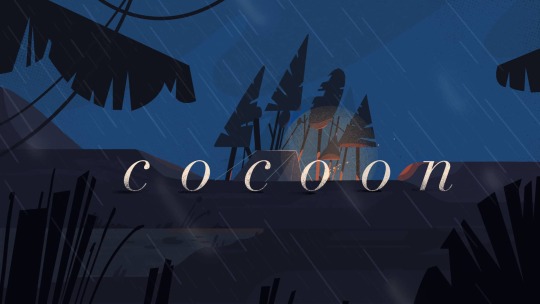
D. Stevers, 2017 [https://vimeo.com/219687902]
Cocoon is a short 2D animation that beautifully visualises the experience of grief; captioned as a ‘modern day Psalm of grief and loss’. The words of Sh’maya, and score of Ryan Taubert are complimented by delicate, poignant visuals, creating a representation of how moving through the raw emotions of grief can lead to new wonders. A cave, storm, cold, and collapse suggest the shock and numbing first reaction to grief, followed by intense sadness. Surreal eyes provoke sensory overload and shadows create a continuing theme of being lost within loss. The motif of a flame is consistent as it grows and is snuffed out over and over again until it multiplies at the end, suggesting a step towards recovery.
A deeply loved animation in the community, many people have come forward with their own experience and how this melancholic piece has comforted them and stayed in their mind as they learn to deal with pain. Though grief is always a subjective experience, and the events of this animation do not apply to all, it can still be used as a gentle, poetic method of educating people on the topic. Created in After Effects by animator Tyler Morgan and designer Sarah Beth Hulver, it aims to be an abstract piece that viewers can find their own relation to.
Borrowed Time
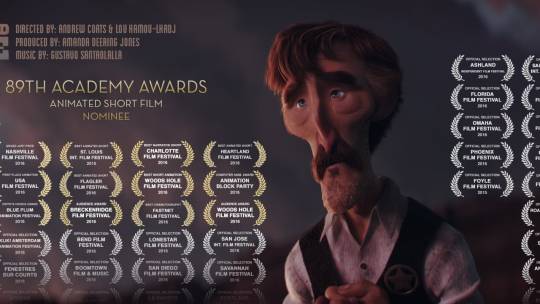
A. Coats & L. Hamou-Lhadj, 2015 [https://vimeo.com/ondemand/100733]
Borrowed Time is a CG animation from two Pixar artists, that took 5 years to complete as part of their Co-op Program that lets animators use resources for independent films. It’s a powerful presentation of the guilt found in grief, and the path towards closure and forgiveness. With each step the protagonist takes, he has to reface a memory is accept the events of the past; though his father’s death was by his hand, it was an accident amidst a sudden and frightening event. Painful feelings resurface but they bring him to the final stage of acceptance.
Whilst Pixar is familiar with showing ‘painful emotions around death in order to underline the joy characters feel around life’, (such as in Up, Toy Story 3, and Inside Out) this animation contains a bigger and bolder shock factor. It’s aimed towards showing that animation can be used as ‘a medium to tell any sort of story’ for any age of audience. By using a familial bond, they have been able to heighten the emotion and more powerfully affect the viewer’s empathetic reaction.
To compare this to Cocoon, you could suggest that ambiguity allows for deeper thinking and relation to the film, but the same affect can be achieved with raw emotional shock power, eliciting honest, relatable reactions
Good Grief
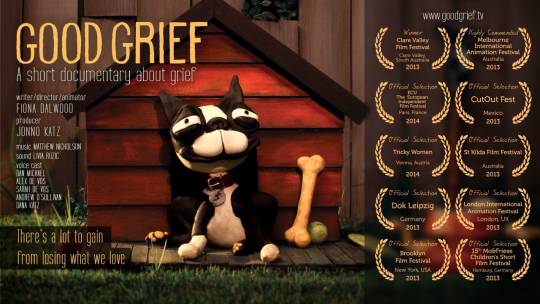
F. Dalwood, 2014 [https://vimeo.com/feedee]
Good Grief is a Claymation documentary and a heartfelt exploration of ‘the lessons we learn from dealing with grief and loss… and what is has taught [the interviewees] about living’. The five voices have all experienced and grown from different kinds of losses: death of a family member, friend, pet, and a leg. In a recognisbale Creature Comforts style, the voices are given to playful animals and vegetables to create a soft visual tone to an emotional narrative.
This film aims to be used as a starting point in the discussion of grief as a transformative experience and used for the education of children and adults alike of a an unjustly stigmatised topic. The interviews are beautifully honest, for example saying, ‘that a really good cry… recharges you’, thus gently stating that grief is a natural experience that shouldn’t be ignored and hidden. Instead that there is a therapeutic power in sharing as ‘relationships matter more’. They do also say that a lot of people around them didn’t care for their grief, or didn’t even ask how they were, reiterating the fact that grief is a topic people are not educated enough about so just avoid (suggesting a need for more content I hope to build upon). I feel this is a great animation to showcase the different causes and reactions to a universal emotion.
Claire Obscur
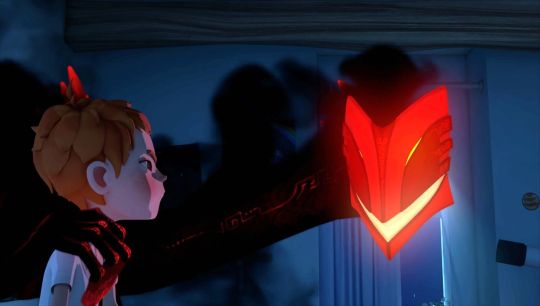
Students from ESMI Bordeaux, 2017 [https://vimeo.com/257307223]
Clair Obscur is a CG animation from several students at Ecole Superieure des Metiers de l’Image, that shows grief through the eyes of a child. After the death of her brother, a girl is terrorised by a personification of grief every night. On this night she uses his sword to defeat the threat and reach acceptance. The use of a truly terrifying and shapeshifting monster brings the intense emotions in grief to life and imply what you will experience without listing emotions a child can’t relate to yet. This film also makes great used of colour and lighting to exaggerate the emotions linked to the childlike imagery; moving from night to day, and dark monster with danger warning red, and a deep yet peaceful tropical blue ocean.
After going through grief myself with minimal preparation, I think a children’s animation is a perfect way to educate people from young ages in a delicate way that can also let themselves come to their own conclusions by presenting the experience as a monster that can be defeated. This film is another example of how animation is a hugely diverse medium, perfect for telling light and hard-hitting stories with clear underlying messages.
Death of a Father

S.Pal, 2017
Death of a Father is a 2D animation that shows the grief of an individual and his family, and how the involvement and incorrect support of others can unintentionally take a great toll on recovery. The protagonist is experiencing a consistent numbness (complimented by a sombre colour palette), yet is being made to move on with ceremonial funeral arrangements and even pushing his father into the crematorium himself. Minimalist in style and dialogue, yet rich in character animation, it creates an intimate tone that makes the ending montage (of the dying father in hospital) even more heartbreaking. Pal notes the body language has ‘subtle nuances no one really cares about, but this is what I fell makes it relatable because of body language is based on our cultural upbringing’.
This film shows that you don’t always get a choice in how, and for how long you grieve. As people aren’t educated enough, they may try to force a perception of normal grief onto others, creating further long-term problems. Furthermore, cultures often have strict rules or customs on the matter, trying to make it an objective experience and leading to disenfranchised grief.
Pal shared about the unstable beginning of the film’s production, highlighting that it can be difficult to work on such a personal project as a collaboration. This could predict problems for me should I decide to continue this idea into the next project, but I think with an abstract retelling of the experience of grief, it could bring the team together as an opportunity to share their own stories.
I also tried to watch Dcera [Daughter] (D. Kashcheeva, 2019), Memorable (B. Collet, 2019), and Sister (S. Song, 2018), which were all Oscar nominated short animations which had themes of grief. However, I was unable to find anywhere to watch them online (and I can’t afford extra rental fees at the moment). From trailers and plot synopses, I could determine that Sister dealt with the ambiguous or disenfranchised type of grief from something never being there (as the protagonist wishes for the sister his parents had to abort amongst China’s one child rule). Memorable deals with the topic of Alzheimer’s, so could suggest anticipatory grief. Dcera is about a strained relationship between a father and daughter, with the daughter not feeling she has received enough love and support with her pain, therefore creating a sort of grief around the loss of an important relationship.
Looking at these animations (in different specialisms from creators with different backgrounds) reiterates the fact that grief comes in many forms, due to many causes, and effects life to different degrees; it is not always due to death and no one will react the exact same (comparison is never a good idea). This suggests that it is difficult to predict how viewers will react to a subjective film, but as long as the narrative is left ambiguous and doesn’t enforce the notion that there is only one real type of grief, it should be a thought-provoking success.
Sources:
Chatterjee, S., (2018). Somnath Pal’s Journey of Self-Discovery. [online] Red Bull. Available at: https://www.redbull.com/in-en/somnath-pal-death-of-a-father (Accessed 25 Sept 2020).
Dalwood, F., (2014). Good Grief. [online] Vimeo. Available at: https://vimeo.com/91157088 (Accessed 25 Sept 2020).
Morgan, S.B., (2017). Cocoon. [online] sarahbethmorgan.com. Available at: https://sarahbethmorgan.com/cocoon (Accessed 25 Sept 2020).
Robinson, T., (2016). This Powerful Short by Two Pixar Animators is darker than Pixar had ever gone. The Verge. [online] Available at: https://www.theverge.com/2016/10/17/13306394/pixar-borrowed-time-animated-short-interview (Accessed 25 Sept 2020).
Sh’maya, (2017) 1 June. Available at: https://www.facebook.com/shmayapoetry/posts/its-finally-here-cocoon-a-film-on-grief-and-loss-the-mighty-dan-stevers-commissi/1788377031179628/ (Accessed 25 Sept 2020).
1 note
·
View note
Video
vimeo
Höhenwahn (Thin Air) from Dynamic Frame on Vimeo.
THIN AIR / HÖHENWAHN is a short film about a father in unusual circumstances. Deep amongst the Swiss Alps, winter resorts and old wooden cabins, Georg experiences disturbing incidents.
CAST Gabriel Stohler-Mauch & Judith Cuénod & Emily Lulgjuraj
CREW Writer & Director – Jonas Ulrich jonasulrich.com Producer – Luzius Fischer & Nicole Boner Director of Photography – Jonas Fischer jonasbfischer.com Composer – Matteo Pagamici Casting – Atelier229 Art Department - Madleina von Reding & Tamara Gysi & Noemi Baldelli Sound Design – Denis Elmaci Gaffer - Lukas Graf Production Coordinator - Niva Rüegg
Produced by DYNAMIC FRAME dynamic-frame.ch
hoehenwahn.ch
AWARDS: - Nomination Zürich Film Award 2019 SCREENINGS: - 34th Warsaw Film Festival** (World Premiere 17.10.2018) - 25th Palm Springs Intl. ShortFest** - 31st Foyle Film Festival** - 25th Visionaria - 7th Ploiesti Intl. Film Festival - 7th Tally Shorts Film Festival - 1st Bristol Rebel Film Festival - 20th Landshuter Kurzfilm Festival - 22th Festival Européen du Court-Métrage de Bordeaux - 7th Changing Perspectives Short Film Festival - 7th Cluj Shorts - 9th OpenEyes Filmfest Marburg
**Oscar®-qualifying Short Film Festivals
1 note
·
View note
Text
TWO HUNDRED FIFTY THINGS AN ARCHITECT SHOULD KNOW
Michael Sorkin
1. The feel of cool marble under bare feet. 2. How to live in a small room with five strangers for six months. 3. With the same strangers in a lifeboat for one week. 4. The modulus of rupture. 5. The distance a shout carries in the city. 6. The distance of a whisper. 7. Everything possible about Hatshepsut’s temple (try not to see it as ‘modernist’ avant la lettre). 8. The number of people with rent subsidies in New York City. 9. In your town (include the rich). 10. The flowering season for azaleas. 11. The insulating properties of glass. 12. The history of its production and use. 13. And of its meaning. 14. How to lay bricks. 15. What Victor Hugo really meant by ‘this will kill that.’ 16. The rate at which the seas are rising. 17. Building information modeling (BIM). 18. How to unclog a Rapidograph. 19. The Gini coefficient. 20. A comfortable tread-to-riser ratio for a six-year-old. 21. In a wheelchair. 22. The energy embodied in aluminum. 23. How to turn a corner. 24. How to design a corner. 25. How to sit in a corner. 26. How Antoni Gaudí modeled the Sagrada Família and calculated its structure. 27. The proportioning system for the Villa Rotonda. 28. The rate at which that carpet you specified off-gasses. 29. The relevant sections of the Code of Hammurabi. 30. The migratory patterns of warblers and other seasonal travellers. 31. The basics of mud construction. 32. The direction of prevailing winds. 33. Hydrology is destiny. 34. Jane Jacobs in and out. 35. Something about feng shui. 36. Something about Vastu Shilpa. 37. Elementary ergonomics. 38. The color wheel. 39. What the client wants. 40. What the client thinks it wants. 41. What the client needs. 42. What the client can afford. 43. What the planet can afford. 44. The theoretical bases for modernity and a great deal about its factions and inflections. 45. What post-Fordism means for the mode of production of building. 46. Another language. 47. What the brick really wants. 48. The difference between Winchester Cathedral and a bicycle shed. 49. What went wrong in Fatehpur Sikri. 50. What went wrong in Pruitt-Igoe. 51. What went wrong with the Tacoma Narrows Bridge. 52. Where the CCTV cameras are. 53. Why Mies really left Germany. 54. How people lived in Çatal Hüyük. 55. The structural properties of tufa. 56. How to calculate the dimensions of brise-soleil. 57. The kilowatt costs of photovoltaic cells. 58. Vitruvius. 59. Walter Benjamin. 60. Marshall Berman. 61. The secrets of the success of Robert Moses. 62. How the dome on the Duomo in Florence was built. 63. The reciprocal influences of Chinese and Japanese building. 64. The cycle of the Ise Shrine. 65. Entasis. 66. The history of Soweto. 67. What it’s like to walk down the Ramblas. 68. Back-up. 69. The proper proportions of a gin martini. 70. Shear and moment. 71. Shakespeare, et cetera. 72. How the crow flies. 73. The difference between a ghetto and a neighborhood. 74. How the pyramids were built. 75. Why. 76. The pleasures of the suburbs. 77. The horrors. 78. The quality of light passing through ice. 79. The meaninglessness of borders. 80. The reasons for their tenacity. 81. The creativity of the ecotone. 82. The need for freaks. 83. Accidents must happen. 84. It is possible to begin designing anywhere. 85. The smell of concrete after rain. 86. The angle of the sun at the equinox. 87. How to ride a bicycle. 88. The depth of the aquifer beneath you. 89. The slope of a handicapped ramp. 90. The wages of construction workers. 91. Perspective by hand. 92. Sentence structure. 93. The pleasure of a spritz at sunset at a table by the Grand Canal. 94. The thrill of the ride. 95. Where materials come from. 96. How to get lost. 97. The pattern of artificial light at night, seen from space. 98. What human differences are defensible in practice. 99. Creation is a patient search. 100. The debate between Otto Wagner and Camillo Sitte. 101. The reasons for the split between architecture and engineering. 102. Many ideas about what constitutes utopia. 103. The social and formal organization of the villages of the Dogon. 104. Brutalism, Bowellism, and the Baroque. 105. How to dérive. 106. Woodshop safety. 107. A great deal about the Gothic. 108. The architectural impact of colonialism on the cities of North Africa. 109. A distaste for imperialism. 110. The history of Beijing. 111. Dutch domestic architecture in the 17th century. 112. Aristotle’s Politics. 113. His Poetics. 114. The basics of wattle and daub. 115. The origins of the balloon frame. 116. The rate at which copper acquires its patina. 117. The levels of particulates in the air of Tianjin. 118. The capacity of white pine trees to sequester carbon. 119. Where else to sink it. 120. The fire code. 121. The seismic code. 122. The health code. 123. The Romantics, throughout the arts and philosophy. 124. How to listen closely. 125. That there is a big danger in working in a single medium. The logjam you don’t even know you’re stuck in will be broken by a shift in representation. 126. The exquisite corpse. 127. Scissors, stone, paper. 128. Good Bordeaux. 129. Good beer. 130. How to escape a maze. 131. QWERTY. 132. Fear. 133. Finding your way around Prague, Fez, Shanghai, Johannesburg, Kyoto, Rio, Mexico, Solo, Benares, Bangkok, Leningrad, Isfahan. 134. The proper way to behave with interns. 135. Maya, Revit, Catia, whatever. 136. The history of big machines, including those that can fly. 137. How to calculate ecological footprints. 138. Three good lunch spots within walking distance. 139. The value of human life. 140. Who pays. 141. Who profits. 142. The Venturi effect. 143. How people pee. 144. What to refuse to do, even for the money. 145. The fine print in the contract. 146. A smattering of naval architecture. 147. The idea of too far. 148. The idea of too close. 149. Burial practices in a wide range of cultures. 150. The density needed to support a pharmacy. 151. The density needed to support a subway. 152. The effect of the design of your city on food miles for fresh produce. 153. Lewis Mumford and Patrick Geddes. 154. Capability Brown, André Le Nôtre, Frederick Law Olmsted, Muso Soseki, Ji Cheng, and Roberto Burle Marx. 155. Constructivism, in and out. 156. Sinan. 157. Squatter settlements via visits and conversations with residents. 158. The history and techniques of architectural representation across cultures. 159. Several other artistic media. 160. A bit of chemistry and physics. 161. Geodesics. 162. Geodetics. 163. Geomorphology. 164. Geography. 165. The Law of the Andes. 166. Cappadocia first-hand. 167. The importance of the Amazon. 168. How to patch leaks. 169. What makes you happy. 170. The components of a comfortable environment for sleep. 171. The view from the Acropolis. 172. The way to Santa Fe. 173. The Seven Wonders of the Ancient World. 174. Where to eat in Brooklyn. 175. Half as much as a London cabbie. 176. The Nolli Plan. 177. The Cerdà Plan. 178. The Haussmann Plan. 179. Slope analysis. 180. Darkroom procedures and Photoshop. 181. Dawn breaking after a bender. 182. Styles of genealogy and taxonomy. 183. Betty Friedan. 184. Guy Debord. 185. Ant Farm. 186. Archigram. 187. Club Med. 188. Crepuscule in Dharamshala. 189. Solid geometry. 190. Strengths of materials (if only intuitively). 191. Ha Long Bay. 192. What’s been accomplished in Medellín. 193. In Rio. 194. In Calcutta. 195. In Curitiba. 196. In Mumbai. 197. Who practices? (It is your duty to secure this space for all who want to.) 198. Why you think architecture does any good. 199. The depreciation cycle. 200. What rusts. 201. Good model-making techniques in wood and cardboard. 202. How to play a musical instrument. 203. Which way the wind blows. 204. The acoustical properties of trees and shrubs. 205. How to guard a house from floods. 206. The connection between the Suprematists and Zaha. 207. The connection between Oscar Niemeyer and Zaha. 208. Where north (or south) is. 209. How to give directions, efficiently and courteously. 210. Stadtluft macht frei. 211. Underneath the pavement the beach. 212. Underneath the beach the pavement. 213. The germ theory of disease. 214. The importance of vitamin D. 215. How close is too close. 216. The capacity of a bioswale to recharge the aquifer. 217. The draught of ferries. 218. Bicycle safety and etiquette. 219. The difference between gabions and riprap. 220. The acoustic performance of Boston Symphony Hall. 221. How to open the window. 222. The diameter of the earth. 223. The number of gallons of water used in a shower. 224. The distance at which you can recognize faces. 225. How and when to bribe public officials (for the greater good). 226. Concrete finishes. 227. Brick bonds. 228. The Housing Question by Friedrich Engels. 229. The prismatic charms of Greek island towns. 230. The energy potential of the wind. 231. The cooling potential of the wind, including the use of chimneys and the stack effect. 232. Paestum. 233. Straw-bale building technology. 234. Rachel Carson. 235. Freud. 236. The excellence of Michel de Klerk. 237. Of Alvar Aalto. 238. Of Lina Bo Bardi. 239. The non-pharmacological components of a good club. 240. Mesa Verde National Park. 241. Chichen Itza. 242. Your neighbors. 243. The dimensions and proper orientation of sports fields. 244. The remediation capacity of wetlands. 245. The capacity of wetlands to attenuate storm surges. 246. How to cut a truly elegant section. 247. The depths of desire. 248. The heights of folly. 249. Low tide. 250. The Golden and other ratios. https://www.readingdesign.org/
1 note
·
View note
Text
57: Chef Sebastian Gibrand Nobel Gala Dinner & Blue Grass Cooking Podcast PGf+w
57: Chef Sebastian Gibrand Nobel Gala Dinner & Blue Grass Cooking Podcast PGf+w
Do not spoil what you have by desiring what you have not; remember what you now have was once among the things you only hoped for. Epicurus
by Paige Donner © July 2020
It seems I haven’t been able to help myself of late, but my mind has been drifting consistently towards peace.
Perhaps it is the numerous protests I see here on our streets in Paris; Perhaps it’s because of the wild, anarchist…
View On WordPress
#aoc bordeaux clairet#blue grass cooking#Bocuse d&039;Or#Bordeaux Food And Wine#Chef Sebastian Gibrand#Cherie du Vin#clairet wine#iot logistics#Local Food And Wine#localfoodwine#Nobel Gala Dinner#Oscars de Bordeaux#Paige Donner#paige donner photography#Paris#paris food and wine#Paris GOODfood+wine#Paris Kentucky#planete bordeaux#podcast
0 notes
Text
by Paige Donner
Appellation Bordeaux Clairet Controllée
Ni Rouge, Ni Rosé, mais toujours fruité et léger! – Château Penin, Clairet
‘Not red, not rosé, but always refreshingly light and fruity.’
Having tasted my way now through 12 AOC Bordeaux Clairets, I feel qualified to conclude that this is Bordeaux’s answer to the lighter reds of the Loire, Alsace and Burgundy. Like some of those, this wine can be drunk chilled in the summer. It’s also a refreshing alternative to the rampant rosés, mostly from Provence and Languedoc, that populate France’s summertime palate. Never mind that Clairet, as a wine, has been around since the 12th C. All things old are ‘new again!’
In fact, these clairets offer a welcome alternative to a wine that is not quite ‘red’ and certainly not rosé. These are wines of substance, nuance and yet still bursting with fruit and subtle aromatics such as white flowers, mint and white fruits, as well as their standard profile of ripe cherries and sunshine kissed raspberries.
BBQs, summer salads, cold buffets laden with tuna, salmon, trout, charcuterie and grilled vegetables are all in need of a bottle or two of AOC Bordeaux Clairet as accompaniment, served chilled, of course at between 8°C and 10°C.
You can find all of these wines at Planète Bordeaux
And follow the Oscars de Bordeaux wine tasting competition on social media @Oscardbdx
1. Château Boutinet – Le Clairet de Boutinet 2019
Brilliant ruby color, top notes of ripe summer dark cherries, fruity + dry at the same time; robust chilled summer wine; a bit of a cherry bomb with just a hint of bonbon anglais. Approachable tannins. Lovely expression of AOC Bordeaux Clairet. Pairing for tangy braised chicken hot off the bbq, grilled vegetable salad, aperitif,
Organic (& label is a tribute to their – Jerome and Nathalie’s – St. Bernard dog). Nathalie is a wine instructor at the CIVB Ecole du Vin de Bordeaux.
https://www.chateauboutinet.fr/
https://www.chateauboutinet.fr/fr/vins/
Chateau de Boutinet featured on Échappées Belles: https://www.youtube.com/watch?v=St8ArwOa3yA
They also offer YOGA AND WINE in the Yurt of Boutinet
So you can approach the tasting in Mindfulness.
Your course offeringis as follows: -45 mn of yoga posture, Asana -15 mn of guided meditation – 30 mn of tasting of 2 wines – 30 mn of discovery of the vineyard in bio conversion Activity to be completely relaxed and enjoy with delight the wine an the present moment Can Mindfulness Meditation and Mindfulness tasting be combined? You will have the answer by practicing!
Le Clairet de Chelivette 2019
Described as a ‘clairet rosé’ the bright, full of sun raspberry color is fresh and inviting, organic and biodynamic cultivation by the new (2014) owners of this 13th c. Chateau. Ample alc. at 14.5%;
Tannins are smooth and subtle A summer chilled wine for patio dining, poultry, seared Ahi tuna, charcuterie
https://www.chelivette.com/bienvenue
Château Lauduc Classic – Bordeaux Clairet
Dark rosé pink with magenta accents; harmonious with a nice acidic balance; nice showing of red fruits here with persistent notes of strawberry, a bit of exotic aromas; 13.5% alc; two brothers, Regis and Hervé Grandeau elaborate these Bordelais family wines; dark robe somewhere between a clairet and a red; plum notes, cherry; long and silky finish ; 75% Merlot, 25% Cab Sauvignon
http://www.lauduc.fr/portfolio/13-lauduc-classic-clairet/
Château de Lisennes – Clairet de Lisennes 2019
4th generation of Bordelais winemakers (the Soubie family) This is a clairet that goes well with gourmet meals and can hold its own at a gastronomic outdoor (or indoor) summer meals; fruity, well-balanced, dry. This clairet walks the line between a classic Clairet and a dry Rosé. Notes of raspberry, cassis, a hint of mint.
Merlot, Cab Franc, Cab Sauv blend Gold Medal winner 2019 for Concours Générale Agricole and also chosen by the CIVB to represent the Bordeaux Clairet AOC
Vineyard cultivation is organic and/or in the process of conversion and is located in the Entre-Deux-Mers region of Bordeaux
https://www.lisennes.fr/index.php?option=com_content&view=article&id=12&Itemid=151
https://www.vigneron-independant.com/chateau-de-lisennes
Château Thieuley
Interesting pairings are possible with this Clairet – yakitori salmon, confit chicken gizzard salad (salade de gésiers confits) a French classic! Also Oeufs Bayonnaise. Which all suggest that this is a gastronomic Clairet, to be served chilled and with appropriately accompanying dishes such as a cold buffet.
An abundance of freshness in this wine that offers a new spin on the classic not-quite-red but deeper and more robust than a rosé wine. It figures notably in the prestigious Guide Hachette.
This is a still wine, but its color and aromas offer a nice sparkle to any table. 12.5% alc
https://www.boutique.thieuley.com/produit/chateau-thieuley-clairet/
Château Degas
Located in the heart of Entre-Deux-Mers , Chateau Degas AOC Bordeaux Clairet 2019 offers up ripe strawberries, notes of raspberry with supple tannins. The chateau itself calls this their ‘vin d’une nuit’ or ‘wine of the night.’ It’s mostly a Merlot blend, rounded out by the two Cabs, Franc and Sauvignoqn.
This Clairet, like many expressions of this AOC, accompanies spicy dishes nicely. Where rosés may be too light and fruity and a red too robust, this Clairet, served chilled, goes nicely with a light curry, Mexican bbq and also middle eastern spicy-sweet-savory dishes.
Eigth generation now work at cultivating their 100 ha of vines, often with grandma working alongside the granddaughters.
Mostly organic or ‘agriculture raisonnée’ (sustainable agriculture).
https://vignoblesdegas.fr/produit/chateau-degas-clairet/
http://vignoblesdegas.fr/
Château Lamothe de Haut
Chilled cherries and ripe strawberries, that is the first sip of this Clairet. While rosés have dominated summer sipping for some time, attuning your palate to a supple yet robust clairet offers up so much more possibilities. Especially when considering difficult pairings such as salads, bbqs and dishes with a bit of kick (spiciness) in them.
This is a fleshier, deeper wine than a rosé even though the vinification process is – nearly – the same as for a rosé. Except here,.the maceration process lasts between 24 and 48 hours.
Fun and fresh, typical of the Bordeaux clairets, it is best to serve this between 8°C and 10°C paired with grilled meats and flavorful vegetables off the bbq, also spicy and exotic foods, like Chinese or Thai or even Mexican. Dominant notes in this Merlot/Cab Franc blend are cherry aromatics. A respectably long finish. They practice sustainable agriculture and Haute Valeur Environnementale vineyard management.
http://www.chateau-lamothe.com/index.php/fr/chateau-lamothe-de-haux/notre-vin-clairet/bordeaux-clairet
https://www.maisondesvinsdecadillac.com/grand-vin-de-bordeaux/chateau-lamothe-de-haux/
This slideshow requires JavaScript.
Marquis de Genissac
Nice balance between power, finesse and softness, this is an exemplary wine of AOC Bordeaux Clairet. Here you have the top notes of red summer fruits like raspberry and strawberry. You’ll find this wine to rival and deepen the complexity of a rosé, while offering more flesh and fruit, though remaining true to its dry wine profile. Smooth tannins, nice acidic balance.
This clairet works as accompaniment for a Paella, salmon pasta dishes, even a tarte Provençale served with spicy charcuterie. You’ll find this wine to be predominantly made from the Merlot varietal. The cave cooperative is located in Entre-Deux-Mers region.
https://www.cavelouisvallon.fr/vins/bordeaux-clairet-marquis-de-genissac/
Château Saint-Catherine Clairet
A deep rose with tendencies towards purple reflections is the color of this expression of Clairet. For the nose, you pick up the juicy freshness of dark reddish-purple table grapes with an accent of sweet, chewy dried fruits. Pizza topped with chorizo and also hand-made fresh pasta are good pairings for this wine. Serve chilled, like all Clairets. Slides easily down the throat. Black ripe fruits tempered by a nice acidity. 100% Merlot.
https://www.chateau-sainte-catherine.fr/fr/
https://www.chateau-sainte-catherine.fr/images/FICHE%20TECHNIQUE%20STE%20CATHERINE%20CLAIRET.pdf
Château La Grande Matairie
White fruits, fresh red summer fruits are dominant in this wine’s bouquet, but it’s the hints of citrus that are what set this clairet apart from the rest. It’s an aromatic and expressive wine with just a touch of spice, it’s en point raspberry color first announcing itself as such. Base varietal here is Cab Franc, with
blendings of Merlot and Cab Sauvignon. You’ll find this chateau in the Entre-Deux-Mers region of Bordeaux.
Pairing this with salads that accent ruby red grapefruit acidity works, also charcuterie and, of course,
any meats or braised vegetables hot off thegrill.
http://essentiellevino.be/2019/04/11/entre-deux-mers-le-top-vin-2019/
Château Caminade Haut Guerin
Here in the village of Genissac, their vineyards are just across the Dordogne River from Pomerol, and they benefit from exceptional soils on gravelly plateaus.
The bouquet of this clairet gives off aromas of white flowers as well as the typique ripe red summer fruits. A touch of spice in the mouth that livens up the white flower notes and here you have a clairet whose supple roundness and balance accompanies a hot/cold summer outdoor buffet or aperitif. The appearance of this wine conforms to its AOC of brilliant, transparent ruby sapphire.
http://www.caminadehautguerin.com/
Château Penin
One of the dominant characteristics of a clairet is its persistent vinosity, without being overpowering or heavy. Chateau Penin is situated in Génissac, so not far from Libourne and Pomerol. The color is that of raspberry sapphire extracted here from its 100% Merlot grapes. Finesse and elegance in the mouth, accentuated by tannins that are more pronounced than a rosé, but not in the least overwhelming. Smooth, acidic balance, fruity. Serve chilled; goes well with slightly spicy Asian foods, like Kung Pao chicken or Korean Bim Bap.
http://www.chateaupenin.com/fr/index.php?option=com_content&view=article&id=3&Itemid=13
@BordeauxFoodVin & BordeauxFoodAndWine.com
Contact Paige Donner @http://PaigeDonner.info
© Paige Donner 2020
TO CONTACT PAIGE DONNER FOR SPEAKING/HOSTING/PRODUCING PAIGEDONNER.INFO FOR MORE INFO ABOUT PARIS GOODFOOD+WINE AND A COMPLETE SHOW LINEUP GO TO LOCALFOODANDWINE.WORDPRESS.COM AND OUR WEBSITE PARISFOODANDWINE.NET & PARISFOODANDWINES.COM
INSTAGRAM @PAIGEFOODWINE TWITTER @PARISFOODWINE
Listen to Paris GOOD food + wine on :
All photos (where noted) copyright 2018 Paige Donner FoodWine.photography
iTunes – Paris GOODfood+wine /
Media Engagements, speaking and collaborations: contact PaigeDonner.info
Clairet Bordeaux AOC – Oscars de Bordeaux 2019 Summer by Paige Donner Appellation Bordeaux Clairet Controllée Ni Rouge, Ni Rosé, mais toujours fruité et léger! - Château Penin, Clairet…
#@oscarsbdx#Bordeaux Food And Wine#bordeauxfoodvin#Cherie du Vin#clairet#Clairet Bordeaux AOC#Entre Deux Mers#food#localfoodandwine#Oscars de Bordeaux#Paige Donner#paris good food and wine#Planete Bordeaux#travel#wine#wine tasting
0 notes
Photo

Los Signos del zodiaco en citas de pensadores
Cada una de las citas o pensamientos está ubicado en uno de los 12 signos del zodiaco. Leyendo las citas podemos comprender las 12 energías universales de una forma diferente, original, pero igualmente instructiva.
Signo Aries
· El viaje más largo comienza con el primer paso.
· Hallaré un camino o me lo abriré. (Aníbal)
· Nadie sabe de lo que es capaz hasta que lo intenta. (Publio Siro)
· La contemplación es un lujo mientras que la acción es una necesidad. (Henri Bergson)
· La respuesta más rápida es la acción. (Proverbio americano)
· Todo comienzo tiene su encanto. (Goethe)
· El principio es la mitad de todo. (Pitágoras)
· No me arrepiento en absoluto de haber corrido todos los riesgos por aquello que me importaba. (Arthur Miller)
Signo Tauro
· Disfrutar de todos los placeres es insensato; evitarlos, insensible. (Plutarco)
· Estimar es crear, es convertir las cosas valoradas en tesoros y joyas (F. Nietzsche)
· El placer da lo que la sabiduría promete. (Voltaire)
· Mientras se gana algo, no se pierde nada. (Miguel de Cervantes Saavedra)
· ¿Quieres ser rico? Pues no te afanes en aumentar tus bienes sino en disminuir tu codicia. (Epicuro de Samos)
· El que está satisfecho con su parte es rico. (Lao Tsé)
· La riqueza consiste mucho más en el disfrute que en la posesión. (Aristóteles)
Signo Géminis
· La variedad es la madre de la diversión. (Disraeli)
· No vivimos propiamente para el conocimiento, sino para la pasmosa y abundante amenidad en el buscar y en el encontrar de éste (F. Nietzsche)
· La duda es la escuela de la verdad. (Sir Francis Bacon)
· Una buena conversación debe agotar el tema, no a los interlocutores. (Winston Churchill)
· Es un milagro que la curiosidad sobreviva a la educación reglada. (A. Einstein)
· La curiosidad intelectual es la negación de todos los dogmas y la fuerza motriz de libre examen. (José Ingenieros)
· El hombre que no sabe callar, tampoco sabe hablar. (Publio Siro)
· La duda es uno de los nombres de la inteligencia. (Jorge Luis Borges)
Signo Cáncer
· La mano que mece la cuna rige el mundo. (Peter de Vries)
· La patria no es la tierra. Los hombres que la tierra nutre son la patria. (Rabindranath Tagore)
· Una patria es una asamblea de hogares. (Henri Bordeaux)
· La tradición te recuerda de dónde vienes y adónde vas.
· El recuerdo es el perfume del alma. (George Sand)
· El lugar donde nacen los niños y mueren los hombres, donde la libertad y el amor florecen, no es una oficina ni un comercio ni una fábrica. Ahí veo yo la importancia de la familia. (Gilbert Keith Chesterton)
· En mi casa he reunido juguetes pequeños y grandes, sin los cuales no podría vivir. El niño que no juega no es niño, pero el hombre que no juega perdió para siempre al niño que vivía en él y que le hará mucha falta. (Pablo Neruda)
Signo Leo
· Pongo mi fuego en mi obra y mi obra multiplica mi fuego.
· La humildad es la vanidad bien administrada.
· Un líder es aquel que sueña y crea.
· Liderazgo es la capacidad de transformar una visión en realidad.
· La conciencia sólo puede existir de una manera, y es teniendo conciencia de que existe. (Jean Paul Sartre)
· La manera de hacer es ser. (Lao Tsé)
· El individuo ha luchado siempre para no ser absorbido por la tribu. Si lo intentas, a menudo estarás solo y a veces asustado. Pero ningún precio es demasiado alto por el privilegio de ser uno mismo. (F. Nietzsche)
· Todos los artistas tienen en común la experiencia de la distancia insondable que existe entre la obra de sus manos, por lograda que sea, y la perfección fulgurante de la belleza percibida en el fervor del momento creativo: lo que logran expresar en lo que pintan, esculpen o crean es sólo un tenue reflejo del esplendor que durante unos instantes ha brillado ante los ojos de su espíritu. (Juan Pablo II)
Signo Virgo
· La inspiración existe, pero tiene que encontrarte trabajando. (Pablo Ruiz Picasso).
· La función última de la crítica es que satisfaga la función natural de desdeñar, lo que conviene a la buena higiene del espíritu. (Fernando Pessoa)
· Ordenar bibliotecas es ejercer de un modo silencioso el arte de la crítica. (Jorge Luis Borges)
· Todo lo racional es real; todo lo real es racional. (Hegel)
· Puede considerarse bienaventurado y no pedir mayor felicidad el hombre que ha encontrado su trabajo. (Thomas Carlyle)
· Obró mucho el que nada dejó para mañana. (Baltasar Gracián)
· No puedo parar de trabajar. Tendré toda la eternidad para descansar. (Madre Teresa de Calcuta)
· El arte del descanso es parte del arte de trabajar. (J. E. Steinbeck)
· El orden es el placer de la razón pero el desorden es la delicia de la imaginación. (Paul Claudel)
· Para tener buena salud lo haría todo menos tres cosas: hacer gimnasia, levantarme temprano y ser persona responsable. (Oscar Wilde)
· La salud es un estado transitorio entre dos épocas de enfermedad y que, además, no presagia nada bueno. (Winston Churchill)
Signo Libra
· La belleza no mira, sólo es mirada. (A. Einstein)
· Amar no es mirar el uno al otro, sino mirar los dos en una misma dirección. (Antoine de Saint -Exupéry)
· El amor es ciego, pero el matrimonio abre los ojos. (Georg Lichtenberg)
· La diplomacia te saca de un problema en el que el tacto te hubiera evitado meterte. (Brian Bowling)
· El deseo de agradar es al espíritu lo que el adorno a la belleza. (Voltaire)
· Es bastante difícil no ser injusto con lo que uno ama. (Oscar Wilde)
· El hombre en su esencia no debe ser esclavo, ni de sí mismo, ni de los otros, sino un amante. Su único fin está en el amor. (Rabindranath Tagore)
· No hay camino para la paz. La paz es el camino. (Mahatma Gandhi)
· El amor abre el paréntesis; el matrimonio lo cierra. (Víctor Hugo)
· A veces, uno se horroriza de descubrirse a sí mismo en otro. (Julián Green)
Signo Escorpio
· En esta vida hay que morir varias veces para después renacer. Y las crisis, aunque atemorizan, nos sirven para cancelar una época e inaugurar otra. (Eugenio Trias).
· Hay que aprender a salir limpio de los asuntos sucios y, si es preciso, a lavarse con agua sucia. (F. Nietzsche)
· Un hombre que no ha pasado a través del infierno de sus pasiones, no las ha superado nunca. (Carl G. Jung)
· Sólo las pasiones, las grandes pasiones, pueden elevar el alma a las grandes cosas. (Diderot)
· ¿La envidia, el odio, la lujuria…, todas esas pasiones han sido arrojadas del alma para que ésta no sea sino una pieza de hielo? (Henry Moore)
· Las pasiones son los viajes del corazón. (Paul Morand)
Signo Sagitario
· La vía del exceso lleva al palacio de la sabiduría. (William Blake)
· No treparás nunca en vano por las montañas de la verdad, ya sea que hoy llegues a subir muy alto o que ejercites tus fuerzas para poder subir muy alto mañana. (F. Nietzsche)
· La creencia no es el principio, sino el fin de todo conocimiento. (Goethe)
· Sólo comprendemos aquellas preguntas que podemos responder. (F. Nietzsche)
· Hay dos maneras de difundir la luz… ser la lámpara que la emite o el espejo que la refleja. (Lin Yutang)
· Daría todo lo que sé, por la mitad de lo que ignoro. (Descartes)
· La sabiduría es hija de la experiencia. (Leonardo Da Vinci)
· En filosofía son más esenciales las preguntas que las respuestas. (Karl Jaspers)
Signo Capricornio
· El tiempo hace justicia y pone todas las cosas en su sitio. (Voltaire)
· Para llegar al momento de la realización es preciso atravesar el desierto de los años estériles (Rabindranath Tagore)
· Considera las contrariedades como un ejercicio. (Seneca)
· El tiempo es la sustancia de la que estoy hecho. (Jorge Luis Borges)
· La perfección se logra al fin, no cuando no hay nada que agregar, sino cuando ya no hay nada que obtener. (Antoine de Saint-Exupéry)
· La disciplina es la parte más importante del éxito. (Truman Capote)
· La vida exige a todo individuo una contribución y depende del individuo descubrir en qué consiste. (Viktor Frankl)
· La verdad es hija del tiempo, no de la autoridad. (Sir Francis Bacon)
Signo Acuario
· Vivir es inventar. (F. Nietzsche)
· ¿Cuál es la señal de la libertad realizada?: no sentir vergüenza de sí mismo (F. Nietzsche)
· El cambio es la única cosa inmutable. (Schopenhauer)
· Sólo la renovación puede mantener. El que se queda parado, se retrasa. (Everhardus Johannes Potgieter)
· El hombre está condenado a ser libre. (Jean Paul Sartre)
· La libertad de conciencia se entiende hoy día, no sólo como la libertad de creer lo que uno quiera, sino también de poder propagar esa creencia. (Jonathan Swift)
· Es verdaderamente libre aquel que desea solamente lo que es capaz de realizar y que hace lo que le agrada. (Jean Jacques Rousseau)
· La rebeldía es la virtud original del hombre. (Schopenhauer)
Signo Piscis
· La vida es como un soñar despierto. Cuanto más inteligente y comprensivo es un hombre, tanto más siente la sublime contingencia de su vida, de sus propósitos; tiembla como el durmiente cuando llega un momento en que se da cuenta de que sueña. (F. Nietzsche)
· El que tiene imaginación, ¡con qué facilidad saca de la nada un mundo! (Gustavo A. Becquer)
· La única cosa realmente valiosa es la intuición. (A. Einstein)
· Las grandes elevaciones del alma no son posibles sino en la soledad y en el silencio. (Arturo Graf)
· Hay dos formas de ver la vida: una es creer que no existen los milagros; la otra, es creer que todo es un milagro. (A. Einstein)
· La fantasía no es otra cosa que un modo de memoria emancipada del orden del tiempo. (Coleridge)
· Solamente una vida dedicada a los demás merece ser vivida. (A. Einstein)
286 notes
·
View notes
Text
HANS ZIMMER

HANS ZIMMER LIVE
Hoy, Sony Classical anuncia el lanzamiento del nuevo álbum doble del ganador de dos Premios Oscar® Hans Zimmer, titulado Hans Zimmer LIVE, que saldrá a la venta el 3 de marzo de 2023 y que ya está disponible para reserva. Junto con la noticia de hoy, se ha publicado el primer single, "The Last Samurai Suite".
Consíguelo AQUÍ
Escucha el adelanto AQUÍ
Hans Zimmer LIVE presenta más de dos horas de nuevos arreglos de algunas de las composiciones más populares del legendario compositor de Los Ángeles. El álbum se grabó durante la exitosa gira de conciertos del mismo nombre en Europa en la primavera de 2022. Zimmer creó “suites” de algunas de las melodías más conocidas de bandas sonoras oscarizadas Ò-como Dune y El Rey León, al igual que de clásicos como The Dark Knight, X Men: Dark Phoenix, Dunkirk, Gladiator, Inception, Interstellar, The Last Samurai, Man of Steel, No Time to Die, Pirates of the Caribbean y Wonder Woman 1984.
"Simplemente quería hacer el mejor álbum", dice Zimmer, que grabó Hans Zimmer LIVE como una producción de estudio durante 10 noches, y pasó semanas mezclando el álbum con su amigo y productor, Stephen Lipson. "Quería crear una oportunidad para que la música respirara de forma diferente, en su propio contexto. Para esta aventura, estoy encantado de haber contado con el mejor equipo posible de colaboradores".
Junto con su banda de 20 integrantes "The Disruptive Collective", que incluye a compañeros musicales de larga data, la Orquesta y el Coro de la Ópera de Odessa, Hans Zimmer ha creado un espectáculo musical épico que fusiona arreglos ambient de clásico y elementos electrónicos con el poderoso sonido de una banda de rock.
"The Disruptive Collective" cuenta con músicos que llevan mucho tiempo colaborando con Zimmer, como los cantantes y compositores Lisa Gerrard (Gladiator), Lebo M. (The Lion King) y Loire Cutler (X Men: Dark Phoenix), la chelista Tina Guo (Wonder Woman) y Nick Glennie-Smith (director musical de la banda). Otros solistas son Andrew Kawczynski (sintetizador, percusión), Pedro Eustache (vientos), Refi (vocalista), Rusanda Panfili (voz), Guthrie Govan (guitarras), Andy Pask (bajo vertical), Aicha Djidjelli (batería), Steven Doar (percusión, teclados), Molly Rogers (voz), Juan García Herreros [Snow Owl] (bajo eléctrico), Nile Marr (guitarras), Leah Zeger (voz), Holly Madge (batería), Aleksandra Šuklar (percusión). Hans Zimmer toca varios instrumentos en el álbum.
Hans Zimmer LIVE estará disponible en los servicios de streaming en estéreo y en los formatos inmersivos Dolby Atmos y Sony 360 RA, para su descarga digital, así como en un DigiPac de 2 CD y en un set limitado de vinilo audiófilo de 4 x 180 g.
Zimmer ha llevado a cabo con gran éxito la gira Hans Zimmer Live por todo el mundo y recientemente ha concluido la primera parte de su gira europea en abril de 2022. Los fans podrán seguir disfrutando de la gira de conciertos Hans Zimmer LIVE en abril de 2023. Para más información, visita: www.hanszimmerlive.com
HANS ZIMMER LIVE – FECHAS DE LA GIRA 2023
23 de abril
Oberhausen, DE
Rudolf Weber Arena
25 de abril
Antwerp, BE
Sportpalais Antwerp
27 de abril
Frankfurt, DE
Festhalle Frankfurt
29 de abril
Stuttgart, DE
Hanns-Martin-Schleyer-Halle
01 de mayo
Turín, IT
Pala Alpitour
03 de mayo
Bologna, IT
Unipol Arena (aplazado desde 2022)
06 de mayo
Niza, FR
Palais Nikaia
07 de mayo
Montpellier, FR
La Sud de France Arena
09 de mayo
Bordeaux, FR
Arkea Arena Bordeaux
11 de mayo
Bilbao, ES
Bilbao Exhibition Centre
13 de mayo
Lisboa, PT
Altice Arena
16 de mayo
Madrid, ES
WiZink Center
20 de mayo
Hannover, DE
ZAG Arena
22 de mayo
Zurich, CH
Hallenstadion Zurich
24 de mayo
Munich, DE
Olympiahalle Munich
26 de mayo
Berlín, DE
Mercedes-Benz Arena
28 de mayo
Hamburgo, DE
Barclays Arena
30 de mayo
Cracovia, PL
Tauron Arena Krakow
02 de junio
Praga, AT
02 Arena
03 de junio
Viena, AT
Wiener Stadthalle - Sala D
05 de junio
Budapest, HU
Papp László Sportaréna
06 de junio
Bratislava, SK
Ondrej Nepela Arena (aplazado de 2022)
09 de junio
Colonia, DE
LANXESS Arena
10 de junio
11 de junio
Ámsterdam, NL
Ámsterdam, NL
Ziggo Dome
Ziggo Dome
12 de junio
Rotterdam, NL
Ahoy Rotterdam
14 de junio
Londres, Reino Unido
The O2
15 de junio
Londres, Reino Unido
The O2
16 de junio
Machester, UK
Manchester Arena
18 de junio
Dublín, IE
3Arena
22 de junio
Bruselas, BE
Palais 12
23 de junio
París, FR
Accor Arena
24 de junio
París, FR
Accor Arena
ACERCA DE HANS ZIMMER
Hans Zimmer ha puesto música a más de 500 proyectos en todos los medios, que, combinados, han recaudado más de 28.000 millones de dólares en la taquilla mundial. Ha sido galardonado con dos Premios de la Academia®, tres Globos de Oro®, cuatro Grammys®, un American Music Award y un Premio Tony®. Sus trabajos más destacados incluyen Dune, No Time to Die, Gladiator, The Thin Red Line, As Good as It Gets, Rain Man, la trilogía The Dark Knight, Inception, Thelma and Louise, The Last Samurai, 12 Years A Slave, Blade Runner 2049 (música compuesta con Benjamin Wallfisch), Dunkirk, y el tema de Planet Earth II , además de poner música a películas recientes como Top Gun: Maverick, Wonder Woman 1984 y Kung Fu Panda. Además, Zimmer ha ganado el premio de la Academia® al mérito en música escrita para películas por Dune. En 2019, Zimmer compuso el remake de acción real de El Rey León, por el que recibió una nominación al Grammy® a la mejor banda sonora para medios visuales.
CONECTA CON HANS ZIMMER
HANS ZIMMER LIVE | FACEBOOK | TWITTER | INSTAGRAM
0 notes
Text
TWO HUNDRED FIFTY THINGS AN ARCHITECT SHOULD KNOW
Michael Sorkin
1. The feel of cool marble under bare feet. 2. How to live in a small room with five strangers for six months. 3. With the same strangers in a lifeboat for one week. 4. The modulus of rupture. 5. The distance a shout carries in the city. 6. The distance of a whisper. 7. Everything possible about Hatshepsut’s temple (try not to see it as ‘modernist’ avant la lettre). 8. The number of people with rent subsidies in New York City. 9. In your town (include the rich). 10. The flowering season for azaleas. 11. The insulating properties of glass. 12. The history of its production and use. 13. And of its meaning. 14. How to lay bricks. 15. What Victor Hugo really meant by ‘this will kill that.’ 16. The rate at which the seas are rising. 17. Building information modeling (BIM). 18. How to unclog a Rapidograph. 19. The Gini coefficient. 20. A comfortable tread-to-riser ratio for a six-year-old. 21. In a wheelchair. 22. The energy embodied in aluminum. 23. How to turn a corner. 24. How to design a corner. 25. How to sit in a corner. 26. How Antoni Gaudí modeled the Sagrada Família and calculated its structure. 27. The proportioning system for the Villa Rotonda. 28. The rate at which that carpet you specified off-gasses. 29. The relevant sections of the Code of Hammurabi. 30. The migratory patterns of warblers and other seasonal travellers. 31. The basics of mud construction. 32. The direction of prevailing winds. 33. Hydrology is destiny. 34. Jane Jacobs in and out. 35. Something about feng shui. 36. Something about Vastu Shilpa. 37. Elementary ergonomics. 38. The color wheel. 39. What the client wants. 40. What the client thinks it wants. 41. What the client needs. 42. What the client can afford. 43. What the planet can afford. 44. The theoretical bases for modernity and a great deal about its factions and inflections. 45. What post-Fordism means for the mode of production of building. 46. Another language. 47. What the brick really wants. 48. The difference between Winchester Cathedral and a bicycle shed. 49. What went wrong in Fatehpur Sikri. 50. What went wrong in Pruitt-Igoe. 51. What went wrong with the Tacoma Narrows Bridge. 52. Where the CCTV cameras are. 53. Why Mies really left Germany.
Upto #53 ready reckoner here: https://adamachrati.wordpress.com/category/sorkin-250/
54. How people lived in Çatal Hüyük. 55. The structural properties of tufa. 56. How to calculate the dimensions of brise-soleil. 57. The kilowatt costs of photovoltaic cells. 58. Vitruvius. 59. Walter Benjamin. 60. Marshall Berman. 61. The secrets of the success of Robert Moses. 62. How the dome on the Duomo in Florence was built. 63. The reciprocal influences of Chinese and Japanese building. 64. The cycle of the Ise Shrine. 65. Entasis. 66. The history of Soweto. 67. What it’s like to walk down the Ramblas. 68. Back-up. 69. The proper proportions of a gin martini. 70. Shear and moment. 71. Shakespeare, et cetera. 72. How the crow flies. 73. The difference between a ghetto and a neighborhood. 74. How the pyramids were built. 75. Why. 76. The pleasures of the suburbs. 77. The horrors. 78. The quality of light passing through ice. 79. The meaninglessness of borders. 80. The reasons for their tenacity. 81. The creativity of the ecotone. 82. The need for freaks. 83. Accidents must happen. 84. It is possible to begin designing anywhere. 85. The smell of concrete after rain. 86. The angle of the sun at the equinox. 87. How to ride a bicycle. 88. The depth of the aquifer beneath you. 89. The slope of a handicapped ramp. 90. The wages of construction workers. 91. Perspective by hand. 92. Sentence structure. 93. The pleasure of a spritz at sunset at a table by the Grand Canal. 94. The thrill of the ride. 95. Where materials come from. 96. How to get lost. 97. The pattern of artificial light at night, seen from space. 98. What human differences are defensible in practice. 99. Creation is a patient search. 100. The debate between Otto Wagner and Camillo Sitte. 101. The reasons for the split between architecture and engineering. 102. Many ideas about what constitutes utopia. 103. The social and formal organization of the villages of the Dogon. 104. Brutalism, Bowellism, and the Baroque. 105. How to dérive. 106. Woodshop safety. 107. A great deal about the Gothic. 108. The architectural impact of colonialism on the cities of North Africa. 109. A distaste for imperialism. 110. The history of Beijing. 111. Dutch domestic architecture in the 17th century. 112. Aristotle’s Politics. 113. His Poetics. 114. The basics of wattle and daub. 115. The origins of the balloon frame. 116. The rate at which copper acquires its patina. 117. The levels of particulates in the air of Tianjin. 118. The capacity of white pine trees to sequester carbon. 119. Where else to sink it. 120. The fire code. 121. The seismic code. 122. The health code. 123. The Romantics, throughout the arts and philosophy. 124. How to listen closely. 125. That there is a big danger in working in a single medium. The logjam you don’t even know you’re stuck in will be broken by a shift in representation. 126. The exquisite corpse. 127. Scissors, stone, paper. 128. Good Bordeaux. 129. Good beer. 130. How to escape a maze. 131. QWERTY. 132. Fear. 133. Finding your way around Prague, Fez, Shanghai, Johannesburg, Kyoto, Rio, Mexico, Solo, Benares, Bangkok, Leningrad, Isfahan. 134. The proper way to behave with interns. 135. Maya, Revit, Catia, whatever. 136. The history of big machines, including those that can fly. 137. How to calculate ecological footprints. 138. Three good lunch spots within walking distance. 139. The value of human life. 140. Who pays. 141. Who profits. 142. The Venturi effect. 143. How people pee. 144. What to refuse to do, even for the money. 145. The fine print in the contract. 146. A smattering of naval architecture. 147. The idea of too far. 148. The idea of too close. 149. Burial practices in a wide range of cultures. 150. The density needed to support a pharmacy. 151. The density needed to support a subway. 152. The effect of the design of your city on food miles for fresh produce. 153. Lewis Mumford and Patrick Geddes. 154. Capability Brown, André Le Nôtre, Frederick Law Olmsted, Muso Soseki, Ji Cheng, and Roberto Burle Marx. 155. Constructivism, in and out. 156. Sinan. 157. Squatter settlements via visits and conversations with residents. 158. The history and techniques of architectural representation across cultures. 159. Several other artistic media. 160. A bit of chemistry and physics. 161. Geodesics. 162. Geodetics. 163. Geomorphology. 164. Geography. 165. The Law of the Andes. 166. Cappadocia first-hand. 167. The importance of the Amazon. 168. How to patch leaks. 169. What makes you happy. 170. The components of a comfortable environment for sleep. 171. The view from the Acropolis. 172. The way to Santa Fe. 173. The Seven Wonders of the Ancient World. 174. Where to eat in Brooklyn. 175. Half as much as a London cabbie. 176. The Nolli Plan. 177. The Cerdà Plan. 178. The Haussmann Plan. 179. Slope analysis. 180. Darkroom procedures and Photoshop. 181. Dawn breaking after a bender. 182. Styles of genealogy and taxonomy. 183. Betty Friedan. 184. Guy Debord. 185. Ant Farm. 186. Archigram. 187. Club Med. 188. Crepuscule in Dharamshala. 189. Solid geometry. 190. Strengths of materials (if only intuitively). 191. Ha Long Bay. 192. What’s been accomplished in Medellín. 193. In Rio. 194. In Calcutta. 195. In Curitiba. 196. In Mumbai. 197. Who practices? (It is your duty to secure this space for all who want to.) 198. Why you think architecture does any good. 199. The depreciation cycle. 200. What rusts. 201. Good model-making techniques in wood and cardboard. 202. How to play a musical instrument. 203. Which way the wind blows. 204. The acoustical properties of trees and shrubs. 205. How to guard a house from floods. 206. The connection between the Suprematists and Zaha. 207. The connection between Oscar Niemeyer and Zaha. 208. Where north (or south) is. 209. How to give directions, efficiently and courteously. 210. Stadtluft macht frei. 211. Underneath the pavement the beach. 212. Underneath the beach the pavement. 213. The germ theory of disease. 214. The importance of vitamin D. 215. How close is too close. 216. The capacity of a bioswale to recharge the aquifer. 217. The draught of ferries. 218. Bicycle safety and etiquette. 219. The difference between gabions and riprap. 220. The acoustic performance of Boston Symphony Hall. 221. How to open the window. 222. The diameter of the earth. 223. The number of gallons of water used in a shower. 224. The distance at which you can recognize faces. 225. How and when to bribe public officials (for the greater good). 226. Concrete finishes. 227. Brick bonds. 228. The Housing Question by Friedrich Engels. 229. The prismatic charms of Greek island towns. 230. The energy potential of the wind. 231. The cooling potential of the wind, including the use of chimneys and the stack effect. 232. Paestum. 233. Straw-bale building technology. 234. Rachel Carson. 235. Freud. 236. The excellence of Michel de Klerk. 237. Of Alvar Aalto. 238. Of Lina Bo Bardi. 239. The non-pharmacological components of a good club. 240. Mesa Verde National Park. 241. Chichen Itza. 242. Your neighbors. 243. The dimensions and proper orientation of sports fields. 244. The remediation capacity of wetlands. 245. The capacity of wetlands to attenuate storm surges. 246. How to cut a truly elegant section. 247. The depths of desire. 248. The heights of folly. 249. Low tide. 250. The Golden and other ratios.
Published in: Michael Sorkin, What Goes Up, London: Verso, 2018.
5 notes
·
View notes
Text
Weeks 15-18: The Tour de France and my Internship Wrap-up!
Long time no see everyone!!
These past few weeks have been quite the blur – between visiting new cities, the iREU conference, and wrapping up things in my lab, I’ve had very little time to sit down and write this update. Thankfully however, I found some calm time just recently, on my last Sunday here in France.
To start, after the completion of my final experiment (which thankfully went off without a hitch), myself and Alex begun our own little “Tour de France”, with our first stop being Paris!! It was a long bus ride, but it was well worth it. (And Alex is the MASTER at picking places to stay – our AirBnB in Paris, although a little bit north of the city center, was extravagant. Our host was out of town for the weekend, but he still treated us with a 2011 vintage of some wonderful wine and his apartment was nothing short of stellar.
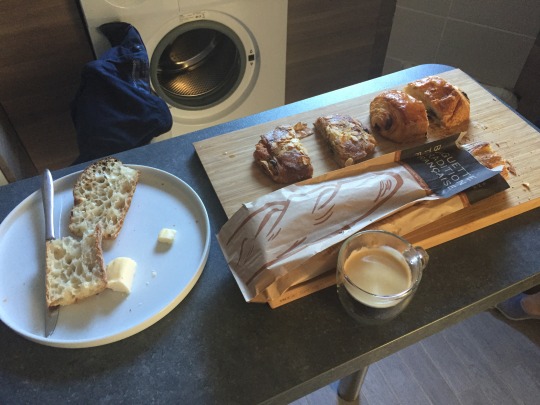

(An early morning breakfast/snack and a cool façade on the way to our first destination!)
Our first stop in Paris early Saturday morning was to the Sacré-Cœur basilica, a newly created icon (early 20th Century) which stood on a hill overlooking the rest of the city. A quick walk up to the top of the church gave way to some FANTASTIC early morning shots of Paris.
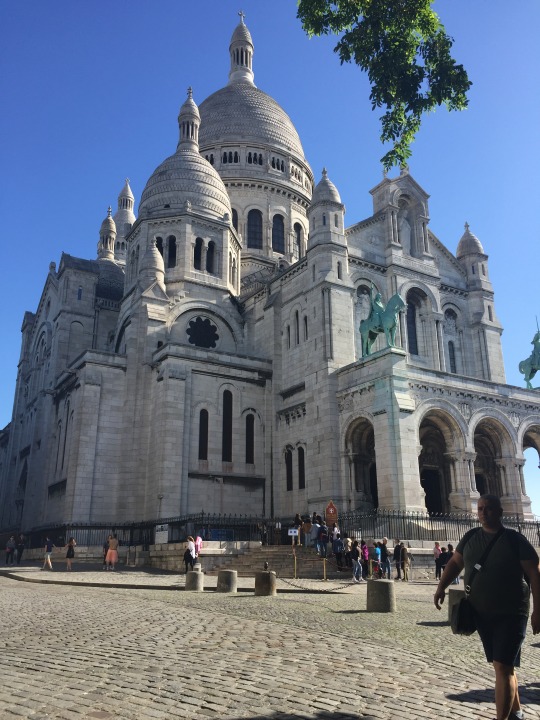

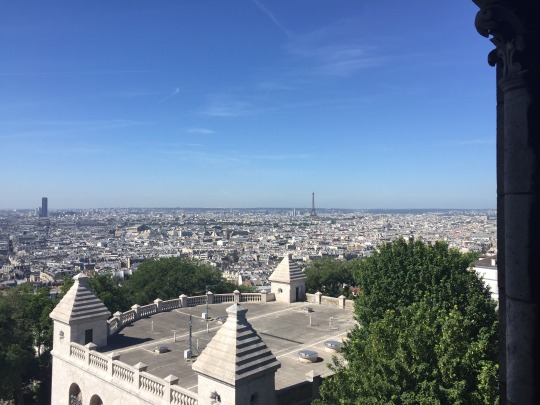
After we were both satisfied with our photos (more of a plug to Alex, his shots are always phenomenal in quality) we made our way down towards the city center and made our way to Les Invalides, where a handful of military museums and prominent tombs lie. ß Most notably, Napoleon himself is laid to rest here. I was able to sneak a few photos of some military exhibits before we made way to the tomb of Napoleon.




(These pictures really doesn’t do the size justice - this ENTIRE BUILDING was dedicated to Napoleon’s shrine. The actual coffin pictured above is ~20-30ft tall on its own, housed below a dome that extended ~100-150ft above it.)
Also of note, Napoleon’s brother, eventual King of Spain as Jose I, is also laid to rest in the same hall as Napoleon. Albeit his shrine is significantly smaller..

(His older brother gets a tiny little corner in his younger brother’s Egyptian Pyramid of a shrine)
We wrapped around the palace for some more photos of the building when we saw President Macron himself!! We were stopped from crossing a driveway that lead into the complex when we saw Macron and his police escort leaving the area!! There was coincidentally a military-band festival at Les Invalides, so we think Macron visited to see the festival, and we caught him right as he was leaving!!

In celebration we stopped by a cute little creperie and made our way to the Eiffel! (No visit to Paris is complete without a photo by the Eiffel Tower!!) Although we didn’t take a trip up to the top, we laughed at the exorbitant prices that we would’ve seen in the Eiffel restaurant, had we gone up!



Our next stop was to the Arc de Triomphe – when Alex visited a long time ago, he took a photo with his sister in front of the Arc. As a surprise and gift to his sister, I helped Alex recreate the exact angle and photo to show his sister and show much time has passed.. Very cute idea.

Before moving towards our final destination of the Notre Dame cathedral, we went full circle to Le Esplanade des Invalides (a park right in front of Les Invalides) to rest our feet and enjoy the wonderful weather.


Day Two in Paris started with a quick visit to a department store, as Alex wanted to pick up some clothing before leaving Paris.
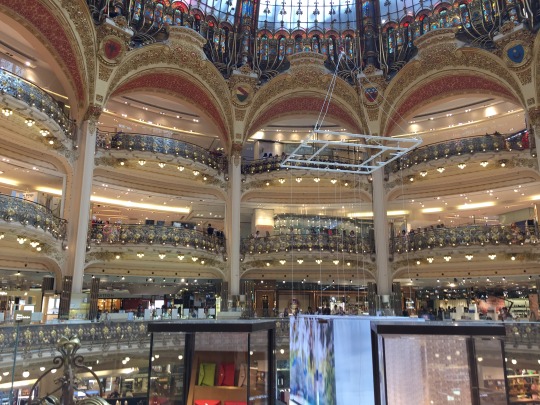
(Yes, this is a department store..)
We took a quick gander at Le Academie Nationale de Musique on our way towards the Louvre! We decided that it would’ve taken too much time out of our day to actually visit the museum, so we were content at taking a couple photos of the courtyard and the pyramidal entrance before heading out to our next stop.
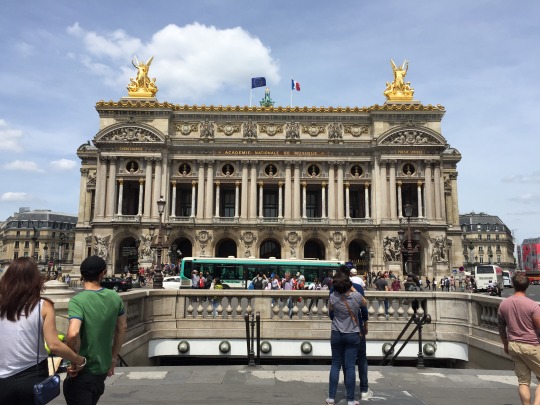
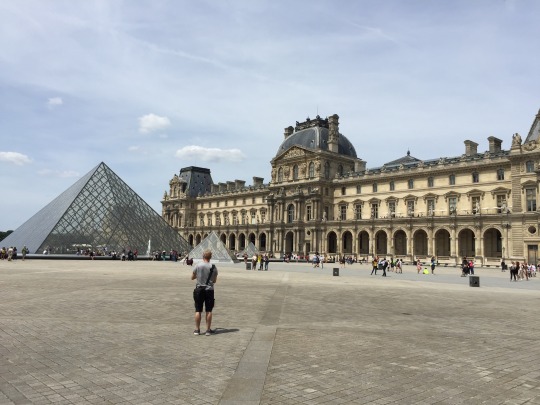
Our next stop was to the Pere Lachaise Cemetery – the largest cemetery in the Paris city proper. Although there are countless well known individuals buried here, of personal interest to me was visiting the grave of Oscar Wilde, author of the well-known novel The Picture of Dorian Gray.

Our final destination of visit in Paris was to Le Jardin du Luxembourg, for a couple minutes rest before returning back to the AirBnB to prepare for our departure.
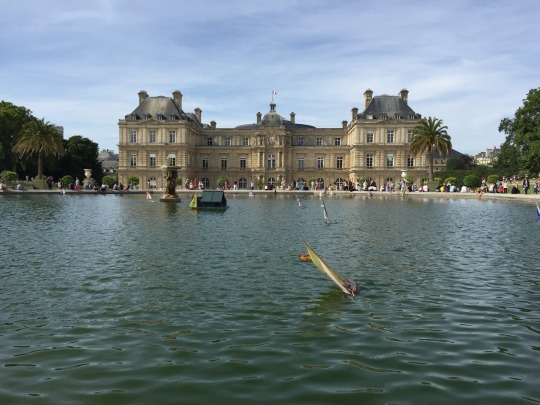

We promptly left for our overnight bus and arrived early in the morning to our next destination, Lyon! Lyon was the host city for our new friend Annika, and we had made plans to visit her in her own city (like she did with us) before we all left for the iREU conference.
After arriving in our hostel and recovering from the long bus ride, we set off to the highest peak in Lyon – “Vieux Lyon”, where La Basilique Notre Dame de Fourviere resides. This MASSIVE basilica overlooks the entire city, and photos do not do this basilica justice – I do not exaggerate when I say that this may have been the greatest cathedral I have ever visited. (Perhaps the Notre Dame in Paris is better, however we didn’t have time to go inside while in Paris)

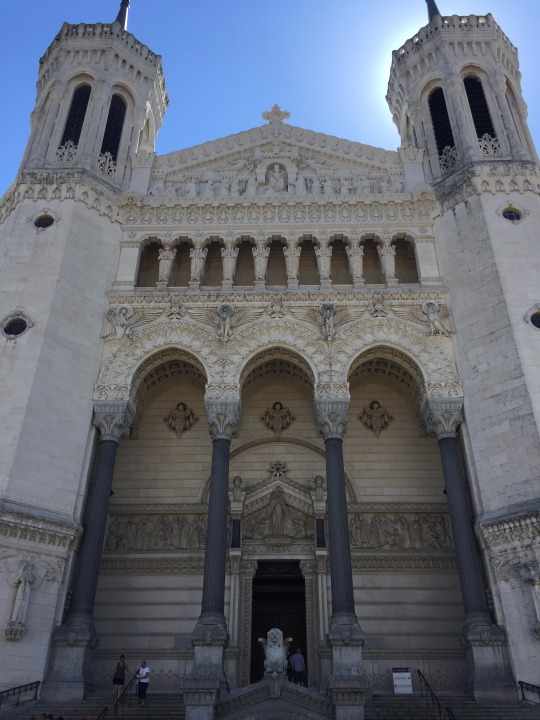

The next stop was arguably my favorite destination of the whole trip, the Theatre Gallo Romain! I adored the small roman ruins here in Bordeaux, and those ruins is merely a single archway. Almost the entirety of this roman theatre is intact, and there are TWO stages! Alex and I went to the top of the ruins and relaxed for a while – the combination of the city view and the ground that I sat on lead for an amazingly content rest. My only dissatisfaction from the visit was that the theatre was fitted with modern tech to make it more applicable for modern day performances – of course this is a great convenience, but it takes away from the historic grandeur of the site to see metal bars and black stages lining this great site.
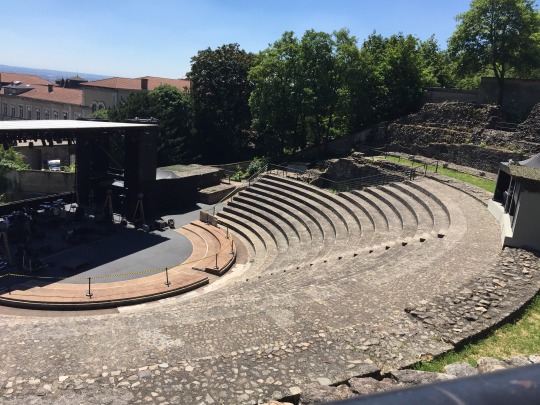
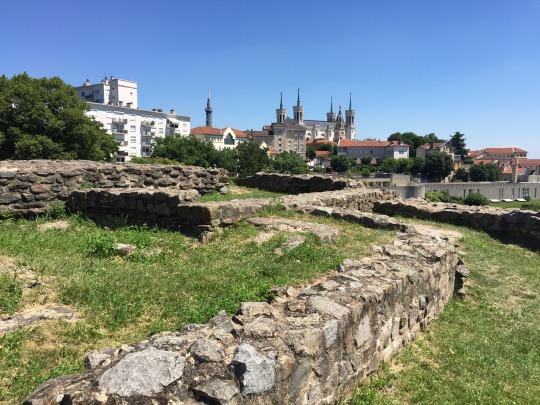
There aren’t many more photos that I took while in Lyon – we spent some quality time with Annika, and our second day in Lyon was mostly spent in the hostel. Alex and I both wanted to prepare for our conference the following day and it happened that France was playing a game in the World Cup, so we spent a lot of time sipping coffee, doing work, and watching football!!
Our final stop in the Tour de France was the culmination of my program here! In Toulouse was the IREU conference, hosted by the Universite de Paul Sabatier! I unfortunately took very few photos of my time in Toulouse, but it was still an amazing experience. The conference was VERY insightful with great talks, and it was wonderful to meet all the other students that were in our iREU, but hosted in different cities. The conference was only two days long, but every night I was in Toulouse, I was fortunate enough to meet up with friends, both old and new. The people who stopped by my poster to hear about my project seemed content with the work I have done with few questions!!
Toulouse wasn’t without its fair share of goodbyes however, as Annika and Kyler both had their flights to the US immediately following the conclusion of the conference. It’s surprising how close of a friendship you can create with some people in such a short period of time – although both Annika and Kyler live in California, I surely hope I see them again.
I did snag this photo while in Toulouse however – for dinner on the first night of the conference, our hosts secured an ENTIRE restaurant for us! It was very homey, it was described by our host as “We wanted to give you a taste of genuine Toulouse food and experience, although it is not the flashiest or most known restaurant, this place is genuine. It will feel like you’re eating food your grandma would make.. If your grandma was french and had lived in Toulouse her whole life!”

Our time in Toulouse ended our “Tour de France”. Although the trip was amazing beyond words, it felt comforting to be back in Bordeaux. It’s been my “home away from home”, and I’ll always have a sweet spot for this stellar city.
My past week in lab here has mostly been wrap-up; I unfortunately won’t have time to finish my analyses of my samples, so I will be bringing them home with me for analysis when I start up my semester back in Binghamton. Since the majority of my time has been downtime, I completed my final report for my experiments here in the lab along with a final presentation that I will be giving to my advisors this week. My final week here in Bordeaux will be spent closing the various accounts and services I have made during my time here, and packing for the big trip home.
It’s very surreal to be at this point. I remember how long the first week went by here, and how difficult I thought the transition was going to be. But here I am, with one week left. This experience has truly been eye opening, both with my professional career and personal development.
I think this will be my last weekly update, as there won’t be much to detail this following week. I may make a short post on my last day here (14/07) just to document my travels to Paris and then out of the country.
I’m going to miss Bordeaux. With the career opportunities now available to me after this internship, I sure hope I find my way back here. For the ~4-5 of you who have been following my posts, thanks for sticking around. And I apologize again for having to put ~6 weeks of content in one large series of posts.
Cheers to this wonderful country one last time. This goodbye is bittersweet, but I know my family and friends will be happy to see me back home. VIVE LA FRANCE!
5 notes
·
View notes
Photo

« Un rêveur est celui qui ne trouve son chemin qu'au clair de lune et qui, comme punition, aperçoit l'aurore avant les autres hommes. » Oscar Wilde #aurore #reveil #newday #reveilmatinal #inthemorning #tostart #inthebeginning #goodmorning #goodvibes #tostarttheday #hello #inthemorning #wakeup #light #instalight #bellelumiere #cielbleu #bordeauxmaville #gironde #bluesky #magiclight #bordeaux #tostart #biencommencerlajournee #morning #morningvibes #morningmotivation (à Bordeaux, France) https://www.instagram.com/p/CSD5YSNK4au/?utm_medium=tumblr
#aurore#reveil#newday#reveilmatinal#inthemorning#tostart#inthebeginning#goodmorning#goodvibes#tostarttheday#hello#wakeup#light#instalight#bellelumiere#cielbleu#bordeauxmaville#gironde#bluesky#magiclight#bordeaux#biencommencerlajournee#morning#morningvibes#morningmotivation
0 notes